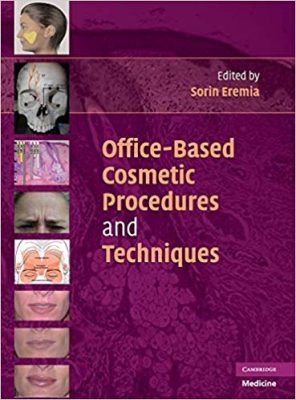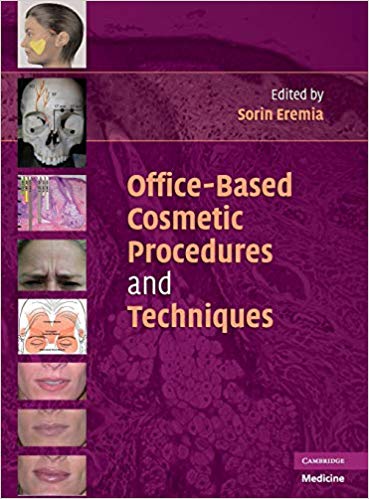 Editor: Sorin Eremia, MD
Editor: Sorin Eremia, MD
Publisher: Cambridge University Press – 367 pages
Book Review by: Nano Khilnani
There were 17.5 million surgical and minimally-invasive cosmetic procedures performed in United States in 2017, according to the American Society of Plastic Surgeons. This represents a growth of about two percent over the 17.157 million such procedures performed in the previous year 2016. The other 1.8 million were surgical procedures such as breast augmentation, liposuction, nose reshaping, eyelid surgery, and tummy tuck.
Of the 17.5 million procedures, the bulk of them, about 15.7 million, or almost 90 percent of the total, were cosmetic ‘minimally invasive’ procedures that included work with Botulinum Toxin Type A (7.23 million), soft tissue fillers (2.69 million), chemical peel (1.37 million), laser hair removal (1.1 million), and micro-dermabrasion (740,000)
Many minimally invasive cosmetic procedures can be performed by certified specialists in office settings without needing to use the facilities and equipment found in hospitals.
This book we’re reviewing is about such office-based cosmetic procedures and techniques.
Eighty-two specialists in various aspects of cosmetic surgery from all over the United States and 10 other countries – Belgium, Canada, Chile, China, France, Germany, Italy Japan. Mexico, and Romania – authored the 76 chapters of this book. Too numerous to list the chapter titles, we instead list below the titles of its five Parts and the Sections within each Part:
- Part I – Anatomy and the Aging Process
- Part II – Anesthesia and Sedation for Office Cosmetic Procedures
- Part III – Fillers and Neurotoxins
- Section 1 – Introduction
- Section 2 – Restylane, Juvederm, and Puragen Families of Nonanimal Stabilized Hyaluronic Acid Fillers
- Section 3 – Collagen Fillers
- Section 4 – Calcium Hydroxylapatite (Radiesse)
- Section 5 – Long-lasting Fillers
- Section 6 – Autologous Far Transfer
- Section 7 – Choosing a Filler
- Section 8 – Neurotoxins
- Section 9 – Fillers and Neurotoxins in Asia and South America
- Part IV–Cosmetic Applications of Light, Radiofrequency, Ultrasound Energy
- Section 1 – Vascular Applications: Lasers and Broadband Light Devices
- Section 2 – Fully Ablative Tissue Remodeling
- Section 3- Nonablative Laser Tissue Remodeling
- Section 4 – Broadband Light Devices
- Section 5 – Radiofrequency
- Section 6 – Fractional Lasers
- Section 7 – Other Photo-rejuvenation Devices
- Section 8 – Hair Removal and Acne: Laser and Light Treatments
- Section 9 – Fat and Cellulite Reduction
- Section 10 – Ultrasonic Fat Reduction Devices
- Part V – Other Procedures
- Section 1 – Suture Suspension Lifts
- Section 2 – Peels and Microderm-abrasion
- Section 3 – Mesotherapy: Injection Lipolysis
To take a look at what you will find inside a typical chapter. Let’s go to Chapter 30: Fillers: How We Do It, laid out from pages 129 to 143, and authored by Deborshi Roy and Neil S. Sadick,
A single paragraph (we’ve split them into two below for easier reading) provides an overview about wide use of fillers in facial rejuvenation and body sculpting, and the good results they provide, as long as you use the right type of filler:
Injectable fillers have become an integral part of nonsurgical enhancement of the face and body. A wide variety of fillers are currently available in the United States, and even more are available worldwide. In the last few years, there has been an explosion in the use of injectable fillers.” ‘’
“Due to the specific nature of each filler material, each one has different applications, advantages, and disadvantages. In this chapter we will be discussing the available fillers and the various techniques we employ during treatment of the face and body.
This is followed by discussions of the following topics:
- Materials and Mechanisms of Action
- Injection Techniques
- Areas of Use
- Upper Face
- Midface
- Lower Face
- Off-Face Use
- Complications
- Technique Related
- Material Related
- Conclusion
This is a well-organized, detailed book with lots of information and examples – provided in a large-book format, along with more than 200 color images – that can help enhance the knowledge (and confidence, with practice) of cosmetic facial and body ‘sculptors’
Editor:
Sorin Eremia, MD is Associate Clinical Professor of Medicine and Director of the Cosmetic Surgery Unit in the Division of Dermatology at the University of California in Los Angeles







